We’re here. The new world. It’s a beautiful landscape without technology, energy, or Aether(born). A world without Gods, their gifts and Nalaar family. Standard Rotation has hit and I’m here to help you approach this new standard format.
Last Friday, Kaladesh and Amonkhet blocks rotated out of Standard. The format now includes Ixalan block, Dominaria, Core Set 2019, and the latest set: Guilds of Ravnica. This change gives us the smallest Standard card pool in two years, and that brings with it its own challenges. You will have to unlearn what you know about the power level of cards in Standard, as previous cards that were considered unplayable now may end up being format-defining. The best example of this is Pack Rat; considered nothing more than a limited bomb, it truly made an impact when Innistrad rotated out and Theros was released.
How to Approach Rotation
In essence, I believe that there are three main ways that you can approach deck building at rotation. First, we can modify existing Standard decks and archetypes by removing the rotating cards and replacing them. Second, we can identify the cards in the latest set that are powerful and build around them. Finally, we can go through each of the past sets to find synergies with new cards. Each of these methods have their pros and cons, so lets go through them.
Modifying Existing decks
With rotation there are going to be some decks which are barely impacted by losing half of the card pool. If we use Ken Yukuhiro’s Mono Blue deck from Worlds as an example, the only main deck cards we lose are the copies of Baral, Chief of Compliance and Slither Blade. However, we can easily replace Slither Blade with Mist-Cloaked Herald and the Baral can be replaced with a cheap flier such as Nightveil Sprite. While this deck would be successful for the first week or two of Standard, it most likely won’t be a lasting deck as it was designed to attack the old metagame.
Using the latest cards
Spoiler season of the new set is one of the most exciting parts of Standard rotation. The power of some of these cards are so obvious that they are built around. From Guilds of Ravnica, the standout cards appear to be Assassin’s Trophy and Doom Whisperer so we have the core of our deck. If we wanted to play these cards together, we need to be playing a Golgari deck at a minimum so then we can look for cards which fit this. This would include Vraska’s Contempt, Ravenous Chupacabra, Glowspore Shaman, and Izoni, Thousand-Eyed. This method can be quite effective, but does contain the risk of creating unfocused decks which are just playing sixty good cards in specific colours rather than considering curve.
Using pre-existing cards
This method is the most time-consuming of the three, but from a deckbuilding perspective it definitely feels the most rewarding. The feeling you get when you build a deck that just works is a similar high to that of the infamous cardboard crack (to me anyway) and is just a big part of the game as the actual gameplay. This method can also be the easiest method if you have been playing Standard pre-rotation, as you start to see patterns emerge.
When Dominaria was released, the reprints of Goblin Warchief, Skirk Prospector, and Siege-Gang Commander seemed a little out of place within the context of the set. However, if you then look back into Ixalan, you see that some more goblins that would work well with them. That means in future sets, you start to keep an eye out for cards which may fit this deck. Apply that to Core Set 2019 and you start to plug some holes in the theoretical deck with the likes of Goblin Trashmaster and Dark-Dweller Oracle. Lo and behold, in Guilds of Ravnica we have even more Goblins to choose from and a deck emerges.
The other way you can apply this method depends on if you have been playing Limited through the set’s time in Standard. Cards that typically are considered “bombs” in draft or sealed will typically make some impact in Standard. These are not always the big flashy mythics such as Lyra Dawnbringer and Rekindling Phoenix, but also include “mythic uncommons” such as Ravenous Chupacabra.
These mythic uncommons however do not always end up making the transition into Standard—think of Aether Revolt’s Ridgescale Tusker and Ixalan’s Charging Monstrosaur. These cards were terrifying to see from an opponent in draft or sealed, but in Standard we build decks that are either quicker than these threats or can easily deal with them that they are not included. Even Ravenous Chupacabra does not see widespread play, regardless of the fact that it is an in built two-for-one.
Five Big Impact Cards
Putting that together, here are five cards I think can make an impact in the first few weeks of Standard:
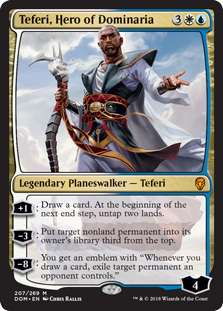
Teferi is very obvious, considering it was the strongest card in Standard just before rotation and ultimately that will not change. The five-mana planeswalker (that’s really a three-mana planeswalker you can only play on turn five) is just so incredibly powerful that while control decks may not appear for the first couple of weeks, Teferi will be included in Standard control decks until his rotation comes.
Decks I expect Teferi to appear in: Turbo Fog, UWx Control decks
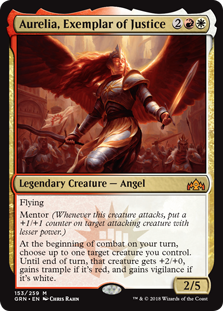
Aurelia, Exemplar of Justice could just as easily be combined with Swiftblade Vindicator as they will most likely be appearing in the same decks, but Aurelia is being a little bit overlooked. To make an impact in Standard, your higher costing cards need to have a relevant ability when they either enter the battlefield, leave the battlefield, or they need to have haste. While Aurelia has none of those, in the Boros style aggressive decks, she is currently competing with Rekindling Phoenix for the same slot.
Aurelia simply fits better in these decks due to her synergy with mentor and the ability to be found with Militia Bugler, but she also fits into other Red-White decks due to her Angel subtype. A curve of Resplendent Angel into Aurelia and then finally into Lyra Dawnbringer should give a lot of decks a hell of a lot of problems.
Decks I expect Aurelia to appear in: Boros Aggro, Red White / Naya Angels
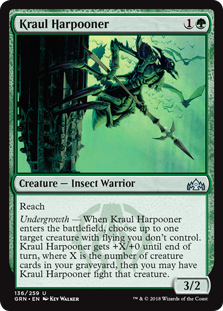
Lets face it, Kraul Harpooner has a mix of abilities which simply don’t appear to mesh well. It is a 3/2 for two (good start) with Reach (sure, I suppose?) with an ETB to fight another creature with flying (wait what?). What makes this card ultimately playable is its aggressive stat line while also being perfect for an archetype that just lost its two drop: Steel Leaf Stompy. From the previous Standard, it looks like it will just fit straight in as a replacement for Scrapheap Scrounger and could be enough to keep the deck on top.
Decks I expect Kraul Harpooner to appear in: Steel Leaf Stompy, GBx sideboards, Pelt Collector decks
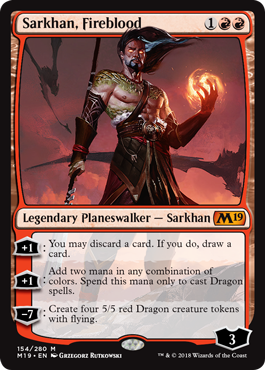
Having more impact in Modern than Standard currently, I think that times could change for the underrated Sarkhan, Fireblood. With mana being incredibly strong for some of the wedges and shards in standard right now, even with the loss of Glorybringer we could definitely see players curve Sarkhan into Niv-Mizzet, the Parun. This shell can also include Nicol Bolas, the Ravager, Demanding Dragon, Bone Dragon, and even Verix Bladewing giving you a hard-hitting team. Now if only Draconic Roar or Silumgar’s Scorn were in Standard again, eh?
Decks I expect Sarkhan to appear in: Grixis Dragons, Grixis Dragons with Chromium, Big Red
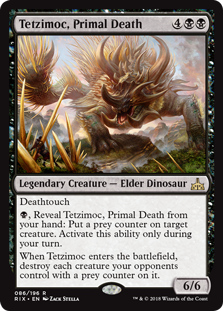
Hear me out on Tetzimoc, Primal Death. As I explained above, in a new Standard format you want to look at the cards that were considered bombs in Limited. Tetzimoc was the absolute king of Rivals of Ixalan limited but never really got a run in Standard. If you wanted to be safer, this slot would be taken with Vraska, Relic Seeker, as the powerful planeswalker is underrepresented. With the printing of Assassin’s Trophy, this could signal a shift in Standard towards a more midrange strategy like the Rock. That could mean the return of the big, mean, deathtouching machine!
Decks that I expect Tetzimoc to appear in: BGx Midrange decks, Mono Black decks
It’s too early to tell how this Standard format will shape up to be by the time the Pro Tour hits; but with SCG Columbus now in the books and a week of Magic Online data, we should get a good idea of the decks we’ll see at Grand Prix Lille and Grand Prix New Jersey at the end of the month. I’ll be back tomorrow to run down the first tournaments from last weekend.
Daniel Roberts (@Razoack) is a UK based player writing about all things Standard. Playing since the release of Gatecrash, he loves nothing better than travelling to European GPs with friends and losing in the feature match area. His best record is 12-3 at GP Barcelona 2017, but he’s aiming for that one more win.

